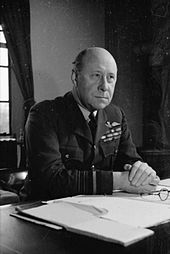William Lawrie Welsh
Sir William Lawrie Welsh ( February 10, 1891 - January 2, 1962 ) was a British aviation pioneer in the Royal Naval Air Service in World War I and Air Marshal in the Royal Air Force in World War II .
Life
He began his officer career in the British Merchant Navy in 1910 . At the beginning of the First World War in 1914 he became a pilot with the RNAS. Welsh took off on August 6, 1915 with a Sopwith Schneider seaplane from the deck of a ship traveling at a speed of 18 knots , the HMS Campania . Wheels had been mounted on the aircraft for the purpose of the experiment. Welsh repeated the attempt on November 3rd. The HMS Campania ran at full speed. At the end of the same year, the British put the HMS Ark Royal , a merchant ship converted into an aircraft carrier , into service.
During a flight six miles northeast of Dunkirk with the Sopwith Baby seaplane No. 8171, Welsh was shot down on April 23, 1917, and he himself was uninjured. After the end of the war Welsh came to the newly formed Royal Air Force and continued his career there. From 1919 to 1922 he was stationed as a major in Egypt and Palestine . In 1924 he got command of the HMS Eagle squadron .
At the beginning of the Second World War he was a command officer at a British aviation school. One of his most important tasks in November 1942 was directing the air strikes on enemy positions during Operation Torch .
After his appointment as Air Force General , William Lawrie Welsh served as Chief of Staff of the Royal Air Force on the newly formed Combined Chiefs of Staff in Washington, DC in January 1942
Welsh retired on December 1, 1944 and stayed in the United States , where he married the widow of the late US Senator Warren Barbour in 1947 . He died on January 2, 1962.
| personal data | |
|---|---|
| SURNAME | Welsh, William Lawrie |
| BRIEF DESCRIPTION | British aviation pioneer in the Royal Naval Air Service in World War I and Air Force general in World War II |
| DATE OF BIRTH | February 10, 1891 |
| DATE OF DEATH | 2nd January 1962 |
